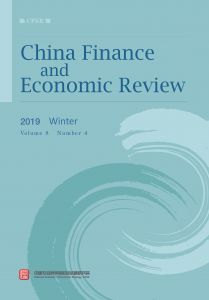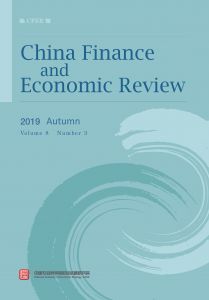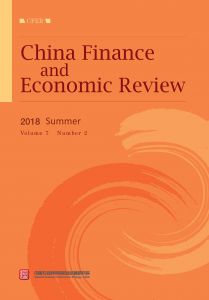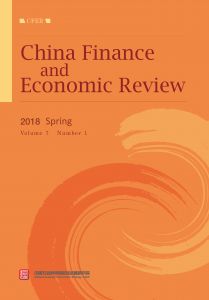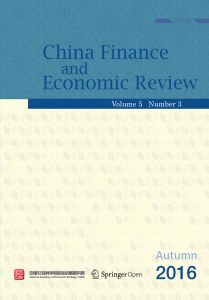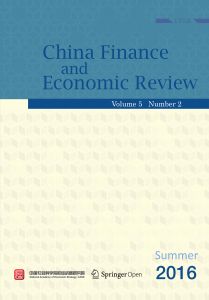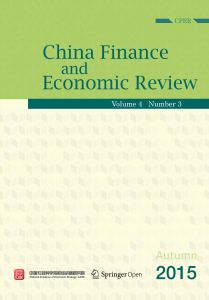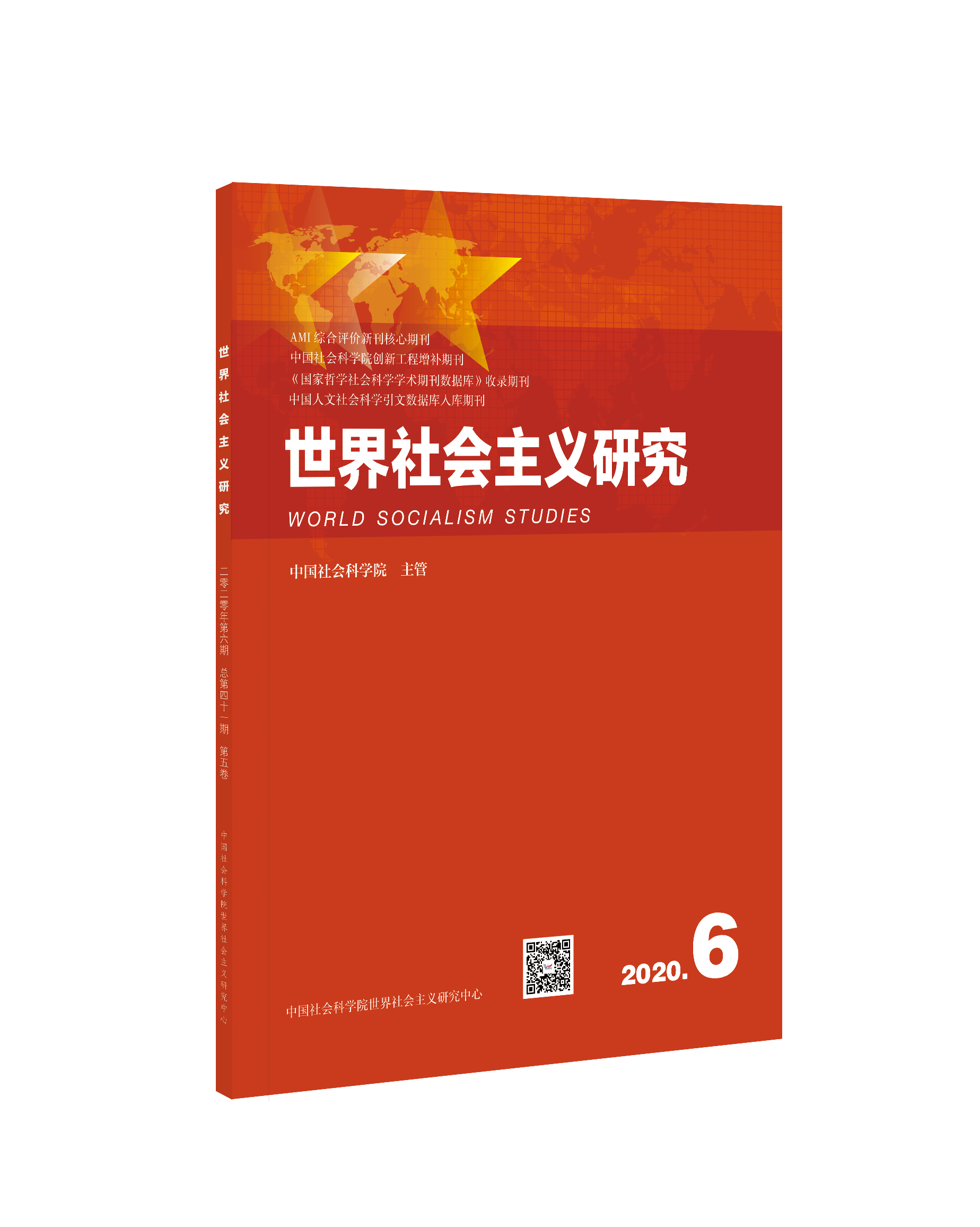最新期刊

目录
过往期刊
参考文献
-
Instructions for Authors
-
编委会
-
Fiscal pressure and local economic growth
-
1. Introduction and literature review
-
2. Institutional background and theoretical analysis
-
3. Indicators, data and empirical strategy
-
4. Empirical Analysis
-
5. Conclusions
-
-
Assessing China’s recent capital outflows: Policy challenges and implications
-
1. Introduction
-
2. Recent literature review
-
3. Driving forces behind China’s recent capital outflows
-
4. Policy challenges and implications
-
5. Conclusions
-
-
The effect of equity structure and influence factors on China’s banking cyclical behavior and monetary policy
-
1. Introduction
-
2. Methods
-
3. Data description
-
4. Hypotheses
-
5. Results and discussion
-
6. Robustness Test
-
7. Conclusions
-
-
Chinese decentralization and income inequality between urban and rural residents
-
1. Introduction
-
2. The mechanism analysis of Chinese decentralization on income inequality
-
3. Variable definitions and data sources
-
4. The empirical analysis of the effect of Chinese decentralization on urban-rural income inequality
-
5. Conclusions and policy recommendations
-
-
Measures and underlying mechanisms of inequality of opportunities in China: Evidence from CGSS data
-
1. Introduction
-
2. Literature review and issues raised
-
3. Empirical strategies
-
4. Results of statistical and empirical analyses
-
5. In-depth analysis and discussion of the IO
-
6. Conclusions and policy implication
-
-
Board independence and fluctuations of corporate performance
-
1. Introduction
-
2. Relevant literature and research hypothesis
-
3. Research design
-
4. Empirical results
-
5. Conclusions
-
-
China Finance and Economic Review被ESCI数据库正式收录
按年份浏览:
- 全部
- 2020
- 2019
- 2018
- 2017
- 2016
- 2015
- 2014
- 2013
[1][1]Acemoglu, D. (2009). Introduction of modern economic growth . Princeton and Oxford: Princeton University Press.
[2][2]Adam, C. S., & Bevan, D. L. (2005). Fiscal deficits and growth in developing countries. Journal of Public Economics , 89 (4), 571-597.
[3][3]Barro, R. (1990). Government spending in a simple model of endogenous growth. Journal of Political Economy , 98 (5), 103-126.
[4][4]Barro, R., & Sala-I-Martin, X. (1992). Public finance in models of economic growth. Review of Economic Studies , 59 (4), 645-661.
[5][5]Cao, Z. Y., Wu, Z. F., Kuang, Y. Q., & Huang, N. S. (2015). Correction of DMSP/OLS night-time light images and its application in China. Journal of Geo-Information Science, 17 (9), 1092-1102.
[6][6]Chen, S. X., & Chen, Z. Y. (2015). Demand response and constraint mechanism of local government debt: Empirical revelation and analysis. Finance & Trade Economics (Cajmao Jingji) , 36 (2), 16-28.
[7][7]Davoodi, H., & Zou, H. F. (1998). Fiscal decentralization and economic growth: A cross-country study. Journal of Urban Economics , 43 (2), 244-257.
[8][8]Dinardo, J., Fortin, N., & Lemieux, T. (1996). Labor market institutions and the distribution of wages, 1973-1992: A semi-parametric approach. Econometrica , 64 (5), 1001-1044.
[9][9]Du, J. L., Lu, Y., & Tao, Z. G. (2015). Government expropriation and Chinese-style firm diversification. Journal of Comparative Economics , 43 (1), 155-169.
[10][10]Fan, Z. Y., Peng, F., & Liu, C. (2016). Political connections and economic growth: Evidence from the DMSP/OLS satellite data. Economic Research Journal (Jingji Yanjiu) , 1, 114-126.
[11][11]Fan, Z. Y., & Zhang, J. (2010). Fiscal decentralization, intergovernmental transfer and market integration. Economic Research Journal (Jingji Yanjiu) , 3, 53-64.
[12][12]Fang, H. S., & Zhang, J. (2014). Reassessing incentive effect of fiscal centralization: Grab hand or aid hand. Management World (Guanli Shijie) , 2, 21-31.
[13][13]Fu, Y. (2010). Fiscal Decentralization, governance and non-economic public goods provision. Economic Research Journal (Jingji Yanjiu) , 8, 4-15.
[14][14]Han, L., & Kung, J. K. (2015). Fiscal incentives and policy choices of local governments: Evidence from China. Journal of Development Economics , 116, 89-104.
[15][15]Henderson, J. V., Storeygard, A., & Weil, D. N. (2012). Measuring economic growth from outer space. American Economic Review , 102 (2), 994-1028.
[16][16]Hodler, R., & Raschky, P. A. (2014). Regional favoritism. Quarterly Journal of Economics , 129 (2), 995-1033.
[17][17]Jia, X. J., & Yue, X. M. (2012). Distribution of equalization for intergovernmental transfer in China. Economic Research Journal (Jingji Yanjiu) , 1, 17-30.
[18][18]Liang, R. B. (2009). Promotion incentives, departmental interests and land lawbreaking under fiscal decentralization. China Economic Quarterly (Jingjixue Jikan) , 9 (4), 283-306.
[19][19]Long, X. N., Zhu, Y. L., Cai, W. X., & Li, S. M. (2014). An empirical analysis of spatial tax competition among Chinese counties based on spatial economic model. Economic Research Journal (Jingji Yanjiu) , 8, 41-53.
[20][20]Lv, B. Y. (2009). Allocation choice and fiscal influence of intergovernmental tax decentralization. Economic Research Journal (Jingji Yanjiu) , 7, 16-27.
[21][21]Oates, W. E. (1993). Fiscal decentralization and economic development. National Tax Journal , 46 (2), 237-243.
[22][22]Shen, K. R., & Fu, W. L. (2005). The relationship between China’s decentralized system in finance and her regional economic growth. Management World (Guali Shijie) , 1, 31-39.
[23][23]Tao, R., Lu, X., Su, F. B., & Wang, H. (2009). China’s transition and development model under evolving regional competition patterns. Economic Research Journal (Jingji Yanjiu) , 7, 21-33.
[24][24]Wang, W. J., & Qin, C. L. (2008). The regional difference of local government behavior and fiscal decentralization growth effect--Judgment, hypothesis and examination based on empirical analysis. Management World (Guali Shijie) , 1, 9-21.
[25][25]Wu, J., He, S., & Peng, J. (2013). Intercalibration of DMSP-OLS night-time light data by the invariant region method. International Journal of Remote Sensing , 34 (20), 7356-7368.
[26][26]Xie, Z. F., & Fan, Z. Y. (2015). Chinese-style tax-sharing system, tax collection centralization and tax competition. Economic Research Journal (Jingji Yanjiu) , 4, 92-106.
[27][27]Xu, K. N., Chen, F. L., & Liu, X. Y. (2015). The truth of China economic growth: Evidence from global night-time light data. Economic Research Journal (Jingji Yanjiu) , 9, 17-29.
[28][28]Yin, H., & Zhu, H. (2011). A study of productive expenditure bias in county-level finance in China. Social Sciences in China (Zhongguo Shehui Kexue) , 1, 88-101.
[29][29]Xu, C. G. (2011). The fundamental institutions of China’s reform and development. Journal of Economic Literature , 49 (4), 1076-1151.
[30][30]Zhang, Y., & Gong, L. T. (2005). The tax share reform, fiscal decentralization, and economic growth in China. China Economic Quarterly , 5 (4), 75-108.
[31][31]Zhang, J. (2012). Zhu Rongji might be right: Understanding the mechanism of fast economic development in China. The World Economy , 35 (12), 1712-1732.
[32][32]Blitz, R. (2015). China clears way for further renminbi weakening. Financial Times , 11 December.
[33][33]Cheung, Y. W., Steinkamp, S., & Westermann, F. (2016). China’s capital flight: Pre-and post-crisis experiences. Journal of International Money and Finance , 66, 88-112.
[34][34]Gunter, F. R. (1996). Capital flight from the People’s Republic of China: 1984-1994. China Economic Review, 7 (1), 77-96.
[35][35]Gunter, F. R. (2004). Capital flight from China: 1984-2001. China Economic Review , 15 (1), 63-85.
[36][36]Hong Kong Monetary Authority. (2016). Half-yearly monetary and financial stability report. http://www.hkma.gov.hk/eng/publications-and-research/half-yearly-monetary-and-financial-stability-report/201603.shtml, 24 March.
[37][37]Hughes, J. (2015). China’s renminbi slips to new 4-year low. Financial Times , 14 December.
[38][38]International Monetary Fund. (2016). The People’s Republic of China-2016 Article IV consultation, IMF Country Report No. 16/270, https://www.imf.org/external/pubs/ft/scr/2016/cr16270.pdf.
[39][39]Ljungwall, C., & Wang, Z. (2008). Why is capital flowing out of China? China Economic Review, 19 (3), 359-372.
[40][40]Wu, F., & Tang, L. (2000). China’s capital flight, 1990-1999: Estimates and implications. Review of Pacific Basin Financial Markets and Policies , 3 (1), 59-75.
[41][41]Akinboade, O. A., & Makina, D. (2009). Bank lending and business cycles: South African evidence. African Development Review , 21 (3), 476-498.
[42][42]Altunbaş, Y., Fazylov, O., & Molyneux, P. (2002). Evidence on the bank lending channel in Europe. Journal of Bank Finance , 26 (11), 2093-2110.
[43][43]Altunbas, Y., Gambacorta, L., & Marques-Ibanez, D. (2009). Bank risk and monetary policy. Journal of Finance Stability , 6 (712), 121-129.
[44][44]Asea, P. K., & Blomberg, B. (1998). Lending cycles. Journal of Economics , 83 (1-2), 89-128.
[45][45]Asea, P. K., & Blomberg, S. B. (1998). Lending cycles. Journal of Econometrics , 83 (1-2), 89-128.
[46][46]Benjamin, M. T., Noronha, A. C., et al . (2011). Bank capital buffers, lending growth and economic cycle: Empirical evidence for Brazil. Ottawa, 12-13.
[47][47]Berger, A. N., & Udell, G. F. (2004). The institutional memory hypo paper and the pro-cyclicality of bank lending behaviour. Journal of Financial Intermediation , 13 (4), 458-495.
[48][48]Bernanke, B. S., & Blinder, A. S. (1988). Credit, money, and aggregate demand. Journal of American Economic Econ Review , 78 (2), 435-439.
[49][49]Bernanke, B., & Gertler, M. (1989). Agency costs, net worth, and business fluctuations. Journal of American Economic Review , 79 (79), 14-31.
[50][50]Chen, K. T., & Gong, L. T. (2011). Lending cycle: Chinese economy 1991~2010. Journal of International Finance Research , 12, 20-28.
[51][51]Chiuri, M. C., Ferri, G., & Majnoni, G. (2002). The macroeconomic impact of bank capital requirements in emerging economies: Past evidence to assess the future. Journal of Bank Finance , 26 (5), 881-904.
[52][52]Cornett, M., Guo, L., Khaksari, S., et al . (2010). The impact of state ownership on performance differences in privately-owned versus state-owned banks: An international comparison. Journal of Financial Intermediation , 19 (1), 74-94.
[53][53]Cull, R., & Pería, M. S. M. (2012). Bank ownership and lending patterns during the 2008-2009 financial crises: Evidence from Latin America and Eastern Europe. Journal of Bank Finance , 37 (12), 4861-4878.
[54][54]Fahlenbrach, R., & Stulz, R. M. (2011). Bank CEO incentives and the credit crisis. Journal of Financial Economics , 99 (1), 11-26.
[55][55]Fan, Z. G., & He, C. Y. (2009). Dialectical views towards the rapid growth of bank loan. Finance Forum , 6, 5-12.
[56][56]Galindo, A., & Micco, A. (2004). Do state owned banks promote growth? Cross-country evidence for manufacturing industries. Journal of Economics Letters , 84 (3), 371-376.
[57][57]Greenwald, B. C., & Stiglitz, J. E. (1993). Financial market imperfections and business cycles. Journal of Economics , 108 (1), 77-114.
[58][58]Huang, X., & Xiong, Q. Y. (2013). Bank capital buffer, lending behaviour and macro economy: Evidence from China. Journal of International Finance Research , 1, 52-65.
[59][59]Jia, C. (2006). The effect of ownership on the prudential behaviour of banks the case of China. Consumer social responsibility Electronic Journal , 33 (1), 77-87.
[60][60]Jiang, Y. K., Liu, Y. W., & Zhao, Z. Q. (2005). Empirical analyses on the efficiency of money channel and credit channel for transmitting monetary policy. Journal of Finance Research , 5, 70-79.
[61][61]Kashyap, A., & Stein, J. C. (2004). Cyclical implications of the Basel II capital standards. Economics Perspective , 28 (1), 18-31.
[62][62]Kiyotaki, N., & Moore, J. (1997). Credit cycles. Journal Political Economy , 105 (2), 211-248.
[63][63]La Porta, R., Lopez de Silanes, F., & Shleifer, A. (2002). Government ownership of banks. Journal of Finance , 57, 265-301.
[64][64]Laeven, L., & Levine, R. (2009). Bank governance, regulation and risk taking. Journal of Finance Economy , 93 (2), 259-275.
[65][65]Leony, L, & Romeu, R. (2011). A model of bank lending in the global financial crisis and the case of Korea. Journal of Asian Economy , 22 (22), 322-334.
[66][66]Micco, A., & Panizza, U. (2006). Bank ownership and lending behaviour. Journal of Economics Letters , 93 (2), 248-254.
[67][67]Micco, A., Panizza, U., & Yañez, M. (2006). Bank ownership and performance. Does politics matter? Journal of Bank Finance , 31 (1), 219-241.
[68][68]Pan, M., & Zhang, Y. R. (2013). Does equity structure have effect on bank lending over business cycles: Evidence from Chinese banking. Journal of Finance Research , 4, 29-42.
[69][69]Sandhu, D., & Gill, K. S. (2005). Does function follow organizational form? Evidence from the lending practices of large and small banks. Social science research network electronic Journal , 76 (2), 237-259.
[70][70]Abramowitz, A. I. (1985). Economic conditions, presidential popularity, and voting behavior in midterm congressional elections. Journal of Politics , 47 (1), 31-45.
[71][71]Bahl, P., Russell, W., Wang, Y. M., Balachandran, A., Voelker, G. M., & Miu, A. (2002). Pawns: Satisfying the need for ubiquitous secure connectivity and location services. IEEE Wireless Communicaitons, 9 (1), 40-48.
[72][72]Bodman, P., & Hodge, A. (2010). What drives fiscal decentralization? Further assessing the role of income. Fiscal Studies, 31 (3), 373-404.
[73][73]Bolton P., & Roland, G. (1997). The breakup of nations: A political economy analysis. Quarterly Journal of Economics, 112 (4), 1057-1090.
[74][74]Chen, G., & He, P. F. (2016). Decentralization of people’s livelihood spending and income gap between urban and rural areas in China. Finance and Trade Research (Caimao Yanjiu), 2, 95-103.
[75][75]Chu, D. Y., & Zhao, F. (2013). Fiscal decentralization, government transfer payments and rural poverty: Analysis of threshold effect based on dual dimensions of revenue and expenditure outside and inside budget. Journal of Finance and Economics (Caijing Yanjiu), 9, 4-18.
[76][76]Chu, D. Y., & Zhang, T. (2016). Financial decentralization and income inequality—An empirical analysis based on panel threshold regression model. Journal of Shanxi University of Finance and Economics (Shanxi Caijing daxue Xuebao) , 38 (1), 12-24.
[77][77]Fujitae, M., Kreugman, P., & Venables, A. (1999). The spatial economy: Cities, regions and international trade . Cambridge: MIT Press.
[78][78]Gao, J. T. (2014). Fiscal decentralization and income gap between urban and rural residents. Journal of Shandong Finance Institute (Shandong Caizheng xueyuan Xuebao) , 3, 67-72.
[79][79]Gil, C., Pascual A., and Rapun, M. (2004). Regional economic disparities and decentralization. Urban Studies, 41 (2), 71-94.
[80][80]Gong, F., & Lu, H. Y. (2013). Financial decentralization and allocation efficiency of local public services. Economic Review (Jingji Pinglun) , 1, 42-51.
[81][81]Lu, M., & Chen, Z. (2008). Convergence to balance: The third way of regional coordinated development between urban and rural. World Economy (Shijie Jingji) , 31 (8), 57-61.
[82][82]Ma, G. R., & Yang, E. Y. (2010). The Chinese style of decentralization, urban-biased economic policy and urban-rural disparity. Research of Institutional Economics (Zhidu Jingjixue Yanjiu) , 1, 10-24.
[83][83]Oates, W. R. (1972). Fiscal federalism . New York: Harcourt Brace Jovanovich.
[84][84]Panizza, U. (1999). On the determinants of fiscal centralization: Theory and evidence. Social Science Electronic Publishing , 74 (1), 97-139.
[85][85]Peterson, R, A. (1995). Relationship marketing and the consumer. Journal of the Academy of Marketing Science, 23 (4), 278-281.
[86][86]Ping, X. Q. (2007). Expansion trend of expenditure scale of local government in China. Comparative Economic & Social Systems (Jingji Shehui tizhi Bijiao), 1, 50-58.
[87][87]Ping, X. Q., & Bai, J. (2006). Fiscal decentralization and local public good provision in China. Finance and Trade Economics (Caimao Jingji) , 2, 49-55.
[88][88]Proud’homme, R. (1995). The dangers of decentralization. The World Bank Research Observer , 10 (2), 201-220.
[89][89]Qian, Y., & Barry, R. (1997). Federalism as a commitment to preserving market incentives. The Journal of Economic Perspectives , 11 (4), 83-92.
[90][90]Rodríguezpose, A., & Ezcurra, R. (2010). Does decentralization matter for regional disparities? A cross-country analysis. Journal of Economic Geography , 10 (5), 619-644.
[91][91]Schenk, P. M., Asphaug, E., Mckinnon, W. B., Melosh, H. J., & Weissman, P. R. (1996). Cometary nuclei and tidal disruption: The geologic record of grater chains on callisto and ganymede. Icarus , 121 (2), 249-274.
[92][92]Sepulveda, C. F., & Martinez-Vazquez, J. (2011). The consequences of fiscal decentralization on poverty and income equality. Environment and Planning , 29 (4),321-343.
[93][93]Stegarescu, D. (2005). Centralizing tendencies in the public sector in Germany. ZEW Discussion Paper, No. 5-46.
[94][94]Tao, R., & Liu, M. X. (2007). Income gap of urban and rural, local government expenditure and fiscal autonomy in China. World Economic Papers (Shijie Jingji Wenhui) , 2, 1-21.
[95][95]Tian, W. M. (2012). Measurement of provincial income Gini coefficient and the trend analysis. Economic Science (Jingji Kexue) , 2, 48-59.
[96][96]Vogt, D., & Letelier, P. S. (2005). New models of general relativistic static thick disks. Physical Review D: Particles and Fields, 71 (8), 118-120.
[97][97]Wang, X. L., & Fan, G. (2005). Income inequality in China and its influential factors. Economic Research Journal (Jingji Yanjiu) ,10, 24-36.
[98][98]Wang, Z. G., & Gong, L. T. (2009). Fiscal decentralization and non-tax revenue of local government. World Economic Papers (Shijie Jingji Wenhui) , 5, 17-38.
[99][99]Zhang, M. X. (2007). Local fiscal expenditures influence on regional disparity. Taxation and Economy (Shuiwu Yu Jingji) , 2, 19-23.
[100][100]Arneson, R. (1989). Equality and equal opportunity of welfare. Philosophical Studies , 56 (1), 77-93.
[101][101]Bai, C. E. (2006). Taking a good start for further Analysis on the Issue of Income inequality. Comparative Studies , 23, Beijing: China Citic Press. (in Chinese)
[102][102]Bourguignon, F., Ferreira, F. H. G., & Menéndez, M. (2007). Inequality of opportunity in Brazil. Review of Income and Wealth , 53 (4), 585-618.
[103][103]Bourguignon, F., Ferreira, F. H. G., & Menéndez, M. (2013). Inequality of opportunity in Brazil: A corrigendum. Review of Income and Wealth , 59 (3), 551-555.
[104][104]Checchi, D., & Peragine, V. (2010). Inequality of opportunity in Italy. Journal of Economic Inequality , 8 (4), 429-450.
[105][105]Chen, B. K., & Cao, W. J. (2013). From opportunity equity to income equality: Income distribution dynamics in China. Comparative Economic & Social Systems (Jingji Shehui Tizhi Bijiao) , 6, 44-56.
[106][106]Chen, B. K., & Lin, Y. F. (2013). Development strategy, urbanization and the urban-rural income inequality in China. Social Sciences in China (Zhongguo Shehui Kexue) , 4, 81-102.
[107][107]Chen, D., & Huang, X. F. (2015). To what extent does the opportunity inequality affect the income inequality? Economic Review (Jingji Pinglun) , 1, 3-16.
[108][108]Chen, L. (2011). An empirical study on China’s intergenerational income mobility: Economic mechanism and public policy. Doctoral Dissertation, Fudan University. (in Chinese)
[109][109]Chen, Q. H. (2010). Interrupted maternal education and child health: The long run health impact of the Chinese Cultural Revolution. Job Market Paper , University of Minnesota.
[110][110]Chen, Z., Lu, M., & Hiroshi, S. (2009). Who entered high-wage industries? The role of social network, hukou and labor productivities. Economic Research Journal (Jingji Yanjiu) , 10, 121-132.
[111][111]Demurger, S., Li, S., & Yang, J. (2012). Earnings differentials between the public and private sectors in China: Exploring changes for urban local residents in the 2000s. China Economic Review , 23 (1), 138-153.
[112][112]Dworkin, R. (1981). What is equality? Part 2: Equality of resources. Philosophy and Public Affair s, 10 (4), 283-345.
[113][113]Ferreira, F. H. G., & Gignoux, J. (2011). The measurement of inequality of opportunity: Theory and an application to Latin America. Review of Income and Wealth , 57 (4), 622-657.
[114][114]Fields, G. S., & Song, Y. (2013). A theoretical model of the Chinese labor market. IZA Discussion Paper Series, No. 7278.
[115][115]Gao, Q., Yang, S., & Li, S. (2013). The Chinese welfare state in transition: 1988-2007. Journal of Social Policy , 42 (4), 743-762.
[116][116]Gong, C. (2008). Household income mobility in urban China, 1992-2001. Working Paper, Australian National University.
[117][117]Guo, Y. M., & Chen, Y. B. (2015). Curing the intergenerational inheritance of income inequality: A perspective of several means. Reform (Gaige) , 9, 41-52.
[118][118]Hassine, N. (2010). Inequality of opportunity in Egypt. World Bank Economic Review , 26 (2), 265-295.
[119][119]Hu, L. H, & Hu, A. G. (2007). How does the income inequality influence the social stability? Jiangxi Social Sciences (Jiangxi Shehui Kexue) , 9, 142-151.
[120][120]Lefranc, A., Pistolesi, N., & Trannoy, A. (2008). Inequality of opportunities vs. inequality of outcomes: are Western societies all alike? Review of Income and Wealth , 54 (4), 513-546.
[121][121]Li, H., Meng, L., Shi, X., & Wu, B. (2012). Does having a cadre parent pay? Evidence from the first job offers of Chinese college graduates. Journal of Development Economics , 99 (2), 513-520.
[122][122]Li, S., Dun, D.S., Luo, C. L. (2013). A study on income distribution of Chinese residents (First Edition) . Beijing: China Social Science Academic Press. (in Chinese)
[123][123]Lin, J., & Yang, Q. M. (2014). Equality of opportunity in income distribution: A literature review. Journal of Northwest A&F University (Social Science Edition) (Xibei Nonglin Keji Daxue Xuebao) , 1, 117-123
[124][124]Marrero, G. A., & Rodríguez, J. G. (2012). Inequality of opportunity in Europe. Review of Income and Wealth , 58 (4), 597-621.
[125][125]Marrero, G. A., & Rodríguez, J. G. (2013). Inequality of opportunity and growth. Journal of Development Economics , 104 (3), 107-122.
[126][126]Ma, X. (2014). Ethnic differences of the intergenerational mobility of education. Journal of South-Central University for Nationalities (Humanities and Social Sciences) (Zhongnan Minzu Daxue Xuebao) , 3, 122-127.
[127][127]Meng, X., & Gregory, R. G. (2002). The impact of interrupted education on subsequent educational attainment: A cost of the Chinese Cultural Revolution. Economic Development and Cultural Change , 50 (4), 935-959.
[128][128]Meng, X., & Zhao, G. C. (2013). The intergenerational effect of the Chinese Cultural Revolution on education . Mimeo, Research School of Economics, College of Business and Economics, The Australian National University.
[129][129]Oaxaca, R. (2007). The challenge of measuring labor market discrimination against women. Swedish Economic Policy Review , 14 (1), 199-231.
[130][130]Ravallion, M., & Lokshin, M. (2000). Who wants to redistribute?: The tunnel effect in 1990s Russia. Journal of Public Economics, 76 (1), 87-104.
[131][131]Roemer, J. (1998). Equality of Opportunity, Cambridge: Harvard University Press.
[132][132]Sen, A. (1985). Commodities and Capabilities , Amsterdam: North-Holland.
[133][133]Shorrocks, A. F. (1980). The class of additively decomposable inequality measures. Econometrica , 48 (3), 613-625.
[134][134]Shorrocks, A. F. (1984). Inequality decomposition by population subgroups, Econometrica , 52 (6), 11369-1385.
[135][135]Song, Y. (2012). Poverty reduction in China: The contribution of popularizing primary education. China & World Economy , 20 (1), 105-122.
[136][136]Song, Y. (2014). What should economists know about the current Chinese hukou system? China Economic Review , 29, 200-212.
[137][137]Tang, L. C. (2011). Thinking on the persistence of students’ classes in the period of compulsory education. Journal of Teaching and Management (Jiaoxue Yu Guanli) , 31, 7-9.
[138][138]Van de Gaer, D., Schokkaert, E., & Martinez, M. (2001). Three meanings of intergenerational mobility. Economica , 68 (272), 519-538.
[139][139]Xia, X. H. (2013). Social impacts of the educational equity, class barrier and income inequality. Seminar on the Economic System Reform, No.1, Renmin University of China.
[140][140]Yao, X. G., & Zhao, L. Q. (2006). A study on intergenerational income flow and transmission path in China: 1989-2000. Working Paper.
[141][141]Yin, H., Li, S., & Deng, Q. H. (2006). Income Mobility in Urban China. Economic Research Journal (Jingji Yanjiu) , 10, 30-43.
[142][142]Zhang, Y., & Eriksson, T. (2010). Inequality of opportunity and income inequality in nine Chinese provinces, 1989-2006. China Economic Review , 21 (4), 607-616.
[143][143]Zhuang, J., & Ali, I. (2010). Poverty, Inequality, and Inclusive Growth in Asia. In J. Zhuang (ed.), Poverty, Inequality, and Inclusive Growth: Measurement, Policy Issues, and Country Studies . London: Anthem Press and Manila: ADB.
[144][144]Zhuang, J. Z., & Ravi, K. (2013). Confronting rising inequality in Asia. Nankai Economic Studies (Nankai Jingji Pinglun) , 1, 3-39.
[145][145]Adams, R. B., Hermalin, B. E., & Weisbach, M. S. (2010). The role of boards of directors in corporate governance: A conceptual framework and survey. Journal of Economic Literature , 48 (1), 58-107.
[146][146]Adams, R., Almeida, H., & Ferreira, D. (2005). Powerful CEOs and their impact on corporate performance. Review of Financial Studies , 18 (4), 1403-1432.
[147][147]Arellano, M., & Bover, O. (1995). Another look at the instrumental variable estimation of error-components models. Journal of Econometrics , 68 (1), 29-51.
[148][148]Bertrand, M., & Mullainathan, S. (2003). Enjoying the quiet life? Managerial behavior following antitakeover legislation. Journal of Political Economy , 111 (5), 1043-1075.
[149][149]Blundell, R., & Bond, S. (1998). Initial conditions and moment restrictions in dynamic panel data models. Journal of Econometrics , 87 (1), 115-143.
[150][150]Bollerslev, Tim. (1986). Generalized autoregressive conditional heteroskedasticity. Journal of Econometrics , 31 (3), 307-327.
[151][151]Cheng, S. J. (2008). Board size and the fluctuations of corporate performance. Journal of Financial Economics , 87 (1), 157-176.
[152][152]Comin, D., & Philippon, T. (2005). The rise in firm-level volatility: Causes and consequences. NBER Macroeconomics Annual , 20, 167-201.
[153][153]Engle, R. F. (1982). Autoregressive conditional heteroscedasticity with estimates of variance of United Kingdom inflation. Econometrica , 50 (4), 987-1008.
[154][154]Fracassi, C., & Tate, G. A. (2012). External networking and internal firm governance. Journal of Finance , 67 (1), 153-193.
[155][155]Granovetter, M. (1985). Economic action and social structure: The problem of embeddedness. The American Journal of Sociology , 191 (3), 481-510.
[156][156]Güner, A. B., Malmendier, U., & Tate, G. (2008). Financial expertise of directors. Journal of Financial Economics , 88 (2), 323-354.
[157][157]Hermalin, B. E., & Weisbach, M. S. (1998). Endogenously chosen boards of directors and their monitoring of the CEO. American Economic Review , 88 (1), 96-118.
[158][158]Hermalin, B. E., & Weisbach, M. S. (2003). Boards of directors as an endogenously determined institution: A survey of the economic literature. Federal Reserve Bank of New York Economic Policy Review , 9 (1), 7-26.
[159][159]Hwang, B. H., & Kim, S. Y. (2009). It pays to have friends. Journal of Financial Economics , 93 (1), 138-158.
[160][160]Kang, S. W., Kim, E. H., & Lu, Y (2012). The limited role of the board of directors. Working Paper, University of Michigan.
[161][161]Kramarzy, F., & Thesmar, D. (2013). Social networks in the boardroom. Journal of the European Economic Association , 11 (4), 780-807.
[162][162]Kuhnen, C. (2009). Business networks, corporate governance and contracting in the mutual fund industry. Journal of Finance , 64 (5), 2185-2220.
[163][163]Li, L, Liu, F. W., & Lu, W. B. (2009). Research into the effect of balance in ownership on the basis of company performance volatility. Management World (Guanli Shijie) , 5, 145-151.
[164][164]Liu, C. (2015). The function of the board of directors and its sociality: Research and review about gray directors. Research on Financial and Economic Issues (Caijing Wenti Yanjiu) , 12, 23-29.
[165][165]Liu, C., Yang, J. D., & Zhou, S. J. (2012). Social relations, the independent directors’ appointment and board independence. The Journal of World Economy (Shijie Jingji) , 12, 83-101.
[166][166]Liu, S. J., Sun, P., & Liu, N. Q. (2003). The ultimate theory of property rights, equity structure and corporate performance. Economic Research Journal (Jingji Yanjiu) , 4, 51-62.
[167][167]Nguyen, B. D. (2012). Does the rolodex matter? Corporate elite’s small world and the effectiveness of boards of directors. Management Science , 58 (2), 236-252.
[168][168]Quan, X. F., & Wu, S. N. (2010). The authoritative strength, quality of information disclosure and the volatility of the company’s performance. Nankai Business Review (NanKai Guanli Pinglun) , 13 (4), 142-153.
[169][169]Sah, R. K., & Stiglitz, J. E. (1986). The architecture of economic systems: Hierarchies and polyarchies. American Economic Review , 76 (4), 716-27.
[170][170]Schwartz-Ziv. M., & Weisbach, M. S. (2013). What do boards really do? Evidence from minutes of board meetings. Journal of Financial Economics , 108 (2), 349-366.
[171][171]Stevenson, W. B., & Radin, R. F. (2009). Social capital and social influence on the board of directors. Journal of Management Studies , 46 (1), 16-44.
[172][172]Weisbach, M. S. (1988). Outside directors and CEO turnover. Journal of Financial Economics , 20 (88), 431-460.
[173][173]Yang, J. D., & Liu, C. (2013). Does manager power affect the variability of corporate performance? Economic Theory and Business Management (Jingji Lilun Yu Jingji Guanli) , 8, 72-83.
[174][174]Yang, J. D., & Liu, C. (2015). Enterprise micro-fluctuation and its implications for the macro-economic policy. Economic Theory and Business Management (Jingji Lilun Yu Jingji Guanli) , 3, 50-59.
[展开]
相关推荐
手机可扫码阅读




